I havenít always been into the dark side of mysticism, no. But my uncle was obsessed. He filled his house with acres of symbolic art, artifacts, and countless talismans against evil. Whenever I visited him, I could feel the power of those symbols pulsing from the walls.
When he died, I became determined to discover the true power of the occult so that I could get to know him better. And if, in the process, I learned a thing or two and could share it with the world, then so much the better. |
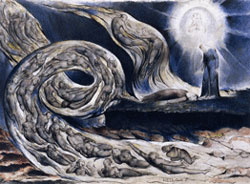 | This painting by William Blake is called Circle of the Lustful: Francesca da Rimini. It hung pride of place in my uncleís bedroom. Iíd never seen anything so full of life and so terrifying before, certainly not in a painting. And it is really, truth be told, what drove me to start researching my uncleís collection.
The painting was actually originally commissioned as an illustration for Danteís Inferno. So it exists as a watercolour and as prints. Blake used it as a way to illustrate Danteís descent into Hell with Virgil. They encounter the adulterous lovers, Francesca da Rimini and Paolo. Iím not sure why they donít give Paoloís last name, but Iím going to do some more digging and find out the truth of their story. But think about it, the symbolism of lovers in hell; the descent into hell. I think thereís something to Danteís story. |
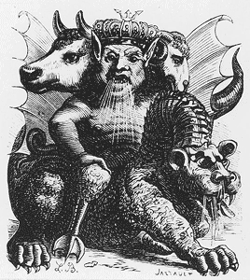
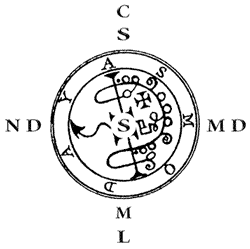 | You may be wondering where I got my name, Tobit, from. Itís an interesting story. It actually comes from the Book of Tobit, which was part of Jewish and Catholic scriptures. Itís a story about demons and marriages ending in death and my namesake gets blinded and then cured by magical means. My uncle kept a copy on his shelf and I was always drawn to it.
But hereís whatís interesting: one of the main characters in the Book of Tobit is this demon called Asmodeus, the king of the demons. Heís the demon of lust and he keeps killing the female protagonistís, Sarahís, husbands on their wedding night. This Asmodeus shows up all over the bible and scriptures. Apparently he was the son of Adam and the angel of prostitution, Naamah, while Adam was married to Lilith. Pretty scandalous.
But it doesnít stop there. Asmodeus shows up throughout history, in the Malleus Maleficarum for instance. And in the Dictionnaire Infernal, Collin de Plancy depicted him with the breast of a man, a cock leg, a serpent tail, and three heads: a man spitting fire, a sheep, and a bull. He even apparently possessed a group of nuns in Loudun, France, in 1634 and was part of an inside joke between Abraham Lincoln and Evert A. Duyckinck.
Apparently people still evoke him to this day, using this seal. Itís pretty creepy. I donít know why youíd want to be possessed by a lustful demon. Come to think of it, I found a few of these symbols around my uncleís place. I guess he had a penchant for the perverted.
|
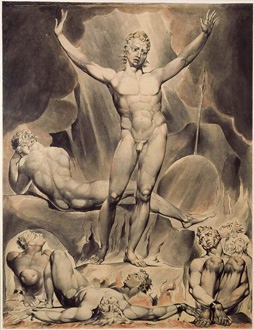 | You may be more familiar with Lucifer, when it comes to demons. But the truth it: Lucifer is actually a fallen angel. Lucifer actually means ďmorning starĒ and, while we often associate him with the Devil, heís not evil at heart really. He was part of a band of rebel angels who were banished to the Underworld. John Milton tells his story way better than I ever could in Paradise Lost. I suggest you read it: itís not as scary as it seems.
William Blake also did some illustrations for Paradise Lost that depict Lucifer, like this one. I think Blake had a bit of the occult in him. Weíd probably have been great friends.
|
 | There are cults devoted to Satan and Lucifer, called the Satanists. Since, for our purposes here, we arenít interested in cults, Iíll let you research that on your own. Satan has a seal, just like Asmodeus does, check it out. |
 | But donít confuse that seal with the pentacle. Satanists have glommed onto the image of the pentacle (or pentagram) as a five-pointed star, but originally it was an amulet used for magical evocations. You would draw the symbol of the spirit you want to get in touch with on the pentacle, and then engage in a ritual to call forward the spirit. There are a whole variety of rituals you can use, whether youíre a Wicca or Spiritualist or Pagan. (Maybe I can use mine to call forth spirits of web design! Ha ha!)
One thing I keep coming across in my research is how people have tried to reach out to the other side all throughout history, yes, but that they also sought to keep themselves protected at home and on the road. |

 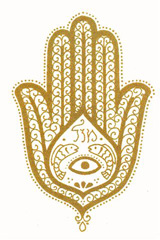 | This symbol here is the St. Benedict Medal and itís one of the oldest medals in the Catholic quest to protect against themselves against evil. Itís also known as ďthe devil-chasing medalĒ because itís got the words Vade retro satana (or ďStep back, SatanĒ) inscribed on the back and a full prayer warding off the Devil on the front. Itís pretty powerful: even though lay Catholics canít perform exorcisms, they can use this medal, along with some other sacraments, to ward of evil should it enter their homes. And to keep it from coming in to begin with. My uncle had one hanging on his bedroom door, along with a Mezuzah and a Hamsa. He was Catholic, so the St. Benedict Medal made sense. I could never figure out what he was doing with Jewish and Islamic symbols, though. Fun fact: Hamsas are found in both Jewish and Islamic traditions but can be traced back to ancient Mesopotamia and Egypt, and even Buddhism. It seems like we are truly connected after all. |
 | Itís really amazing how deeply this occult and mysticism stuff goes. Iím going to research more topics like:
- Labyrinths
- Greek gods
- The asteroids
- Astrological signs
- Alchemy Ė Iíve got a preliminary chart of some symbols you can check out under the Symbols and Signs tab while Iím digging up more info.
- Stonehenge
- Norse mythology
In the meantime, maybe you guys can help me out with this weird rubbing I found in my uncleís desk drawer. My friend said itís a Vigenere cipher full of demon codes and it could kill me. But I donít think that can be true. What do you think? A vigenere cipher is said to be unbreakable without the right key word. I think I need to do more research--I'm sure I'll figure out something if I look in the right place. |






